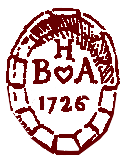Berkeley’s Enslaved
Benjamin Harrison V was born and died at Berkeley. He was a member of the House of Burgesses and the Continental Congress, a signer of the Declaration of Independence, and a governor of Virginia. He also was the owner of 110 enslaved people.
When Benjamin Harrison V died in 1791, an inventory of his enslaved workers was completed. The inventory is unique among the surviving slave inventories. In the inventory, slaves are listed in a sort of genealogical style, with a progenitor listed first and descendants following. Thus, the inventory begins with a superannuated (retired) slave who is valued at 0 pounds. In contrast, the customary slave inventory records men first, from most valuable to least valuable, then women listed in a similar way, followed by children. Superannuated slaves are usually listed last. A copy of the inventory list is on display at Berkeley.
Tobacco was a cash crop in Virginia from the seventeenth century to the twentieth century and provided the main source of income for Berkeley and for most plantations in Virginia. To cultivate the crop, tobacco planters first relied on European indentured servants, but by 1700 had turned to enslaved peoples to work the fields. The conditions enslaved workers faced depended on the size of the plantation or farm where they worked and the type of work they had to do. Household servants, blacksmiths, carpenters, and other skilled workers were better off than field hands. During tobacco farming at Berkeley, most of the enslaved workers were field hands. Men, women, and children might work as long as sixteen hours a day during the harvest and ten or more hours a day in winter. Ready-made clothes were generally given to men twice a year, and everyone received new shoes about once a year. Women were provided with cloth to make dresses for themselves and clothes for their children. The slave communities grew their own vegetables, and food was distributed to families and individuals.
While without legal standing, slave marriages were accepted by most planters. The marriage ceremony might have consisted of a couple “jumping the broom”, a custom that affirmed their commitment to each other before the slave community; a formal wedding in the main house with the planter and his family; or just an agreement from the owner. However, planter’s acceptance of marriage did not always mean that he respected the institution. Selling spouses away from each other was common.
Virginia’s architectural history is not always fully represented in its historical buildings because of the lack of surviving Colonial-Era slave quarters. These structures were generally built cheaply, using perishable materials which decayed rapidly following the Civil War. Very few of these original houses, most of which date to about 30 years prior to the Civil War, still exist. Only the better-built examples tended to survive, and most were repurposed for other uses after emancipation. Slave quarters could be adjacent to the main house, far away from it, or both. At Berkeley, the existing kitchen building would have housed the cook as well as the laundry workers. Skilled workers would have lived near the main buildings, and some of the house servants who were responsible for looking after the children would have lived on the third floor of the manor house.
During the fall of 2018, Berkeley became the movie set of “Harriet”. “Harriet” is based on the story of iconic freedom fighter Harriet Tubman, her escape from slavery, and her mission to free hundreds of slaves through the Underground Railroad. Harriet’s production team transformed Berkeley’s historic buildings, gardens, farmland, woods, ponds, and river shore into the world of Harriet Tubman. Slave quarters were constructed and used for scenes throughout the movie. Following the filming, the reconstructed slave quarters were relocated to the approximate site of the original slave quarters in Berkeley’s historical area. An exhibit is now open where you can see the reconstructed slave quarters and learn about the enslaved people who lived and worked at Berkeley.
For more information on Berkeley’s enslaved visit:
https://charlescity.org/learn/
Message From the Jamieson Family
We believe that Black Americans, Indigenous People, and their descendants deserve justice, respect, and support as they have suffered unimaginable tragedies and losses through enslavement and genocide at the foundation of America.
We believe that everyone in Virginia can come together and utilize history to facilitate empathy, education, and healing. We support and honor the African American community in their efforts to create their narrative and stand up for equality, respect, and justice.
As a historic site and museum, we welcome and encourage all voices. For too long Virginia’s history was told from a perspective that marginalized many communities and perpetuated discrimination. We recognize that enslaved people were present at Berkeley Plantation during the period of tobacco farming in colonial times and up to the Civil War. We are working with researchers and historians to uncover all aspects of this site’s past, and there is much work and responsibility ahead to make this site a place for healing and awareness.
Berkeley Plantation house museum and the surrounding grounds have a responsibility to help preserve these sites and property for future historians and scholars. We welcome new research and educational opportunities which reveal the injustice, resilience, and untold story of all marginalized people. We feel that history should be inclusive and provide both breadth and depth so that we all can move forward collectively as Americans honorably and respectfully. We encourage everyone to share any thoughts and ideas regarding this matter to info@berkeleyplantation.com
Your thoughts are considered valuable insights to our organization.

First Thanksgiving
